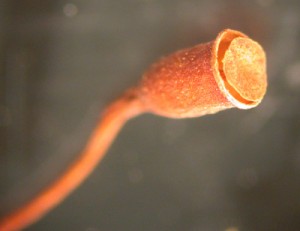Habitat
This species has an interesting distribution. It has been found from Washington to Alaska, and then in Japan. It is commonly found on soil and tree roots.
Gametophyte
Overall structure:
This species, which forms loose to dense tufts, is dull olive green when young and becomes dark-reddish in color as it matures.
Leaf Structure:
The leaves become contorted when they are dry and spread widely (almost plane) when they are moist.
Sporophyte
Sporangium:
B. lescurii is commonly referred to as the “toothless wonder” because it does not have any peristome teeth. The sporangium is yellowish-brown and its epiphragm extends beyond the mouth opening.
Here is a closer look at the toothless sporangium of B. lescurii.


